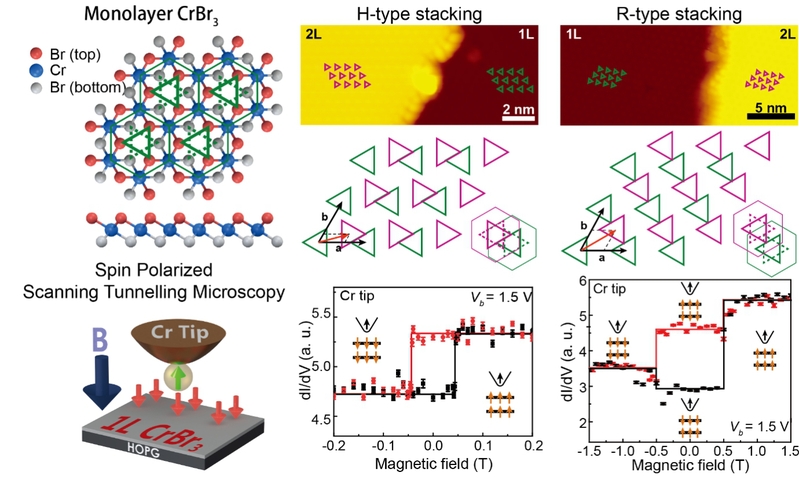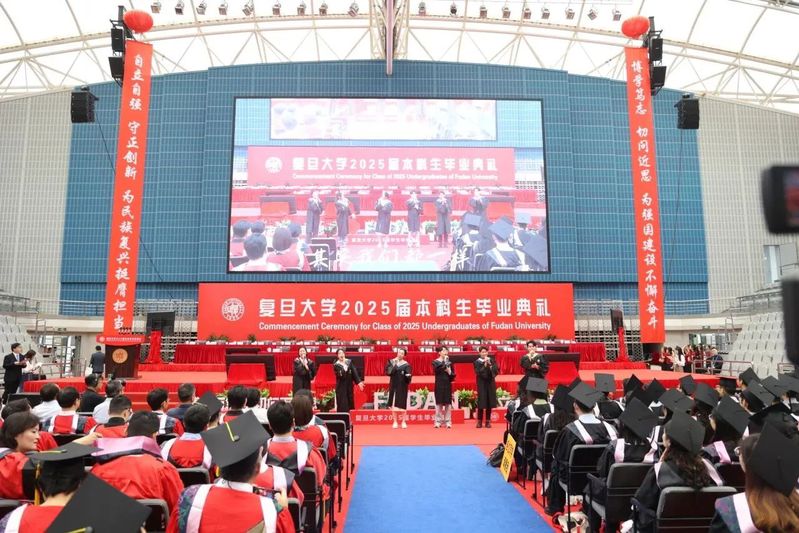Two-dimensional (2D) layered materials are known for its weak van der Waals (vdW) interaction between layers. This weak vdW interaction enables the isolation of graphene and other 2D materials down to the monolayer limit by mechanical exfoliation or so called scotch tape method since 2004. Moreover, weak interlayer vdW interaction allows for the control over the rotational and translational degrees of freedom between layers, creating a host of new materials with distinct stacking symmetries and functionalities.
Newly discovered 2D magnetic materials provide the possibility to tune the stacking structure and understand the correlation between stacking order and interlayer magnetic coupling. Among them, CrX3 (X = Cl, Br, I) attracts special attention. Both bulk and monolayer CrBr3 and CrI3 show out-of-plane ferromagnetism. However, the mechanically exfoliated bilayer CrI3 exhibits unexpected interlayer antiferromagnetic coupling, while the mechanically exfoliated bilayer CrBr3 still maintains interlayer ferromagnetic coupling. Early studies suggest that bulk CrBr3 and CrI3 have similar crystal structures. A crucial question is why there is such a distinct difference in interlayer magnetic coupling between bilayer CrI3 and CrBr3.
A group led by Prof. Chunlei Gao, in collaboration with Prof. Shiwei Wu and Prof.Xiaodong Xu, recently found that the bilayer CrBr3 grown by molecular beam epitaxy (MBE) has two kinds of stacking order with different layer twisting angles: R-type stacking structure, where the adjacent layers are oriented in the same direction, and H-type stacking structure, where the adjacent layers are oriented in the opposite direction. By employing the home-built state-of-the-art spin-polarized scanning tunnelling microscope, they established a direct correlation between stacking order and interlayer magnetic coupling. The result has been published in Science entitled “Direct observation of van der Waals stacking dependent interlayer magnetism” on November 22.

H-type and R-type stacked bilayer CrBr3 measured by spin polarization scanning tunnelling microscopy and spectroscopy
In their experiment, H-type stacked bilayer CrBr3 shows a rectangular-shape ferromagnetic hysteresis loop, in which the two plateaus represent two out-of-plane spontaneous magnetization directions (↓ and ↓), while R-type stacked bilayer CrBr3 shows a loop with four plateaus, which can be explained by the antiferromagnetic coupling between the layers: when the external magnetic field is within ±0.5 T, the magnetization directions of the top layer and the bottom layer are opposite, ↑↓ or ↓↑, corresponding to two of the plateaus atlow magnetic field. When the external magnetic field is higher than ±0.5 T, the magnetization directions of both top and bottom layers are forced to align with the direction of external magnetic field (↑↑ or ↓↓), corresponding to another two of the plateaus at high magnetic fields.
To further prove the interlayer antiferromagnetic coupling of R-type stacked bilayer CrBr3, a non-magnetic tungsten tip (W-tip) is also used. Due to the lack of magnetic contrast, two ferromagnetic configurations (↑↑ and ↓↓) overlap into one plateau, and two antiferromagnetic configurations (↑↓ and ↓↑) overlap into another plateau, consistent with the giant magneto-tunnel resistance effect observed in mechanically exfoliated bilayer CrI3 with interlayer antiferromagnetic coupling. In contrast, no change was observed in ferromagnetically coupled H-type stacked bilayer CrBr3, when a W-tip is used.
This work, for the first time, visualized the atomic structure of 2D magnets and their stacking order, and established the direct correlation between stacking order and interlayer ferromagnetic/antiferromagnetic coupling in real space. Such correlation opens up the opportunity to manipulate 2D magnetism based on twisted bilayers and heterostructures.





